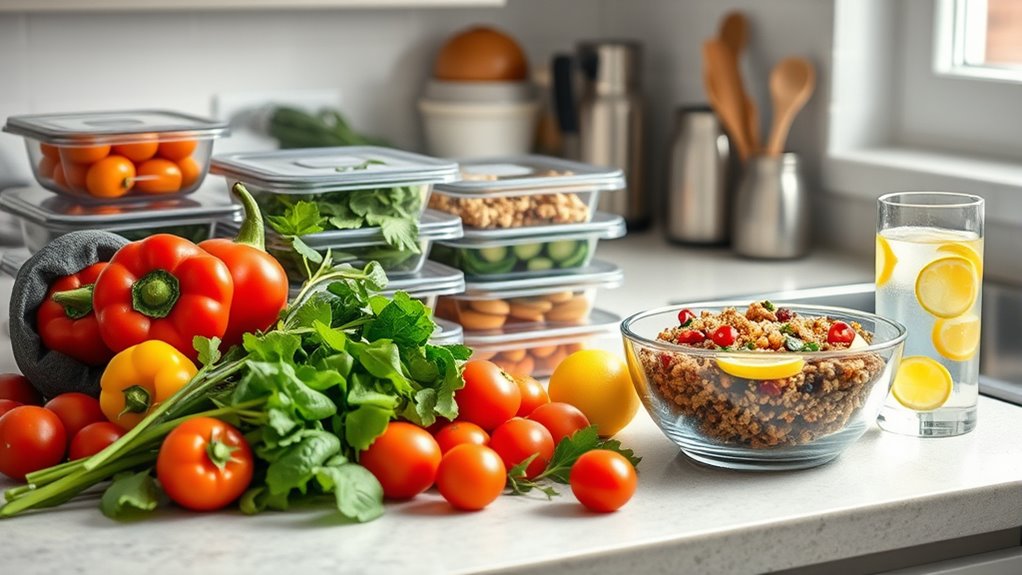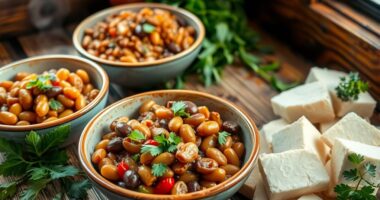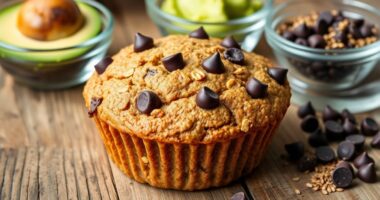To optimize your meal planning as a midlife woman, focus on foods that support bone and heart health, like calcium-rich options, healthy fats, and fiber from whole grains and produce. Prioritize including enough protein at every meal to preserve muscle, and plan your shopping and prep ahead to save time. Adjust portion sizes, incorporate nutrient-dense snacks, and consider hormonal shifts for better energy and mood. Keep exploring for more tips to make your nutrition work for you.
Key Takeaways
- Focus on nutrient-dense, calcium-rich foods and vitamin D to support bone health and prevent osteoporosis.
- Incorporate heart-healthy fats and fiber-rich foods to promote cardiovascular wellness.
- Distribute high-quality protein evenly across meals to maintain muscle mass and support aging.
- Simplify meal planning with batch cooking, organized shopping lists, and versatile ingredients.
- Adjust meal timing and portion sizes to manage hormonal fluctuations and sustain energy and mood.
Assessing Your Nutritional Needs in Midlife

As you enter midlife, your nutritional needs change due to shifts in hormone levels, metabolism, and activity levels. One key aspect is supporting bone health, which becomes more critical with age. Calcium absorption tends to decline, so you need to focus on foods rich in calcium, like dairy, leafy greens, and fortified products. Ensuring adequate calcium intake helps maintain bone density and reduces the risk of osteoporosis. Additionally, vitamin D plays an essential role in calcium absorption, so consider getting enough sunlight or taking supplements if needed. Your body’s ability to absorb nutrients shifts during midlife, making it essential to prioritize nutrient-dense foods. Regularly evaluating your diet allows you to adjust intake to support strong bones and overall health as you age. Incorporating nutrient absorption processes can further optimize your dietary efforts, ensuring you meet your nutritional goals effectively. Moreover, practicing soil health management in your diet—such as choosing organic and minimally processed foods—can support better nutrient uptake and overall well-being.
Prioritizing Protein for Muscle Maintenance
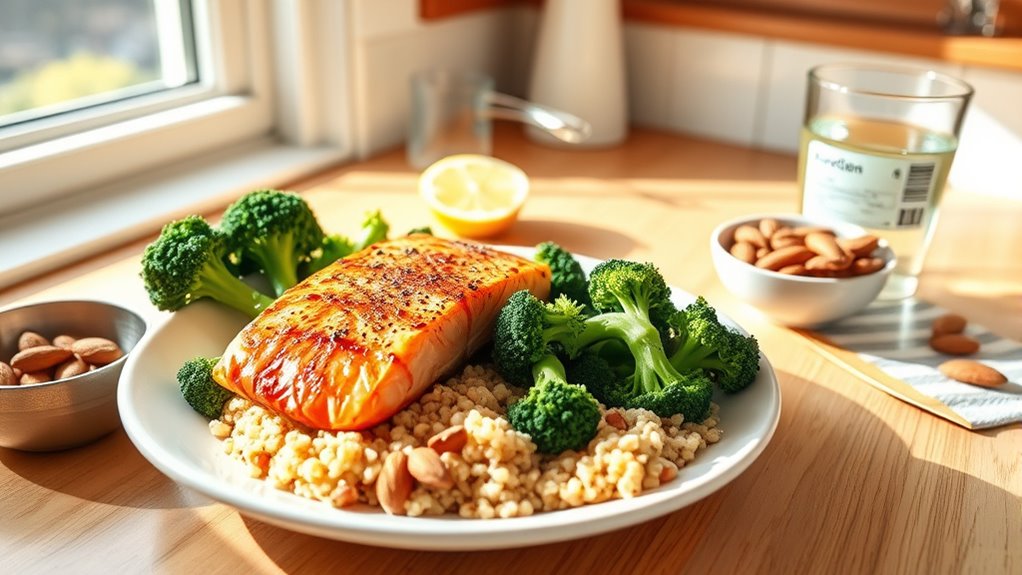
Protein plays a vital role in helping you maintain muscle mass as you age. You should focus on incorporating a variety of sources like lean meats, dairy, beans, and nuts into your meals. Aim for your daily protein intake to support your changing needs and keep your muscles strong. Including diverse protein sources can enhance your overall nutrition and support muscle maintenance. Exploring home decor ideas can create a comfortable environment that encourages healthy habits and well-being. Recognizing the importance of fatherhood can inspire you to nurture your health and well-being through mindful eating habits. Embracing continuous learning about nutrition can further empower you to make healthier choices that benefit your longevity.
Protein’s Role in Aging
Maintaining muscle mass becomes increasingly important as you age, and prioritizing adequate protein intake plays a crucial role in this process. As you grow older, your body needs more protein to help preserve muscle strength and prevent age-related decline. Including protein supplements can be a convenient way to meet your daily needs, especially if your diet falls short. Plant-based proteins, like beans, lentils, and tofu, are excellent options that support muscle maintenance and offer additional health benefits. Consuming enough protein evenly distributed throughout the day helps stimulate muscle repair and growth. Automation technology can also assist in tracking and managing your nutritional intake, making it easier to meet your protein goals. Additionally, proper home cleaning can help reduce indoor allergens that might impact overall health and wellness. Remember, balancing your intake of various protein sources ensures you get all essential amino acids, supporting healthy aging and maintaining your overall vitality. Incorporating nutritional awareness can further enhance your ability to select the right foods for muscle preservation and overall health. Proper planning around retirement planning can also help ensure you have sufficient resources to maintain a healthy diet in later years.
Best Protein Sources
Choosing the right sources of protein is essential for supporting muscle maintenance as you age. Incorporate a variety of options to meet your needs, including plant-based options and dairy alternatives. Good sources include legumes, tofu, tempeh, and quinoa, which provide essential amino acids. Dairy alternatives like soy milk, almond yogurt, and vegan cheese also boost your intake. To diversify your diet, consider these options:
| Animal-based | Plant-based & Dairy Alternatives |
|---|---|
| Eggs | Tofu |
| Chicken | Lentils |
| Fish | Chickpeas |
| Greek yogurt | Edamame |
| Lean beef | Almonds |
Mixing these sources guarantees you maintain muscle mass and enjoy balanced nutrition as you age. Incorporating a variety of protein sources and understanding their nutritional benefits enhances overall nutrient intake and supports optimal health.
Daily Intake Goals
To support muscle health as you age, paying attention to your daily intake of protein becomes increasingly important. You don’t need to obsess over calorie counting, but tracking your protein intake helps guarantee you meet your goals. Aim for about 1.2 to 2.0 grams of protein per kilogram of body weight daily, depending on activity level. Distribute your protein evenly across meals to optimize muscle maintenance. Meal timing matters—try to include a good protein source with each meal and snack to maximize absorption and support muscle repair. Remember, consistent intake throughout the day helps prevent muscle loss and promotes strength as you get older. Incorporating high-quality vacuum cleaners into your cleaning routine can also help reduce dust and allergens that may affect respiratory health. Prioritizing balanced meals with sufficient protein is a simple yet effective strategy to maintain your vitality. Regularly consuming high-quality protein can also aid in reducing the risk of muscle deterioration as you age. Additionally, understanding cheating behaviors and their impact on health can inform more mindful food choices and lifestyle habits. Maintaining a balanced diet with adequate protein can support overall muscle preservation and promote healthy aging.
Incorporating Heart-Healthy Fats and Fiber-Rich Foods
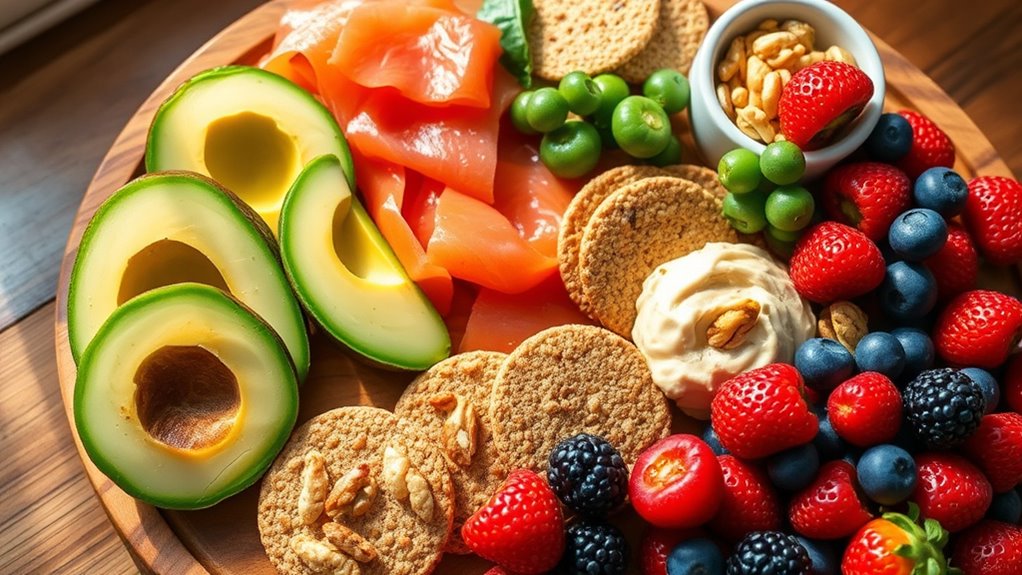
Adding heart-healthy fats and fiber-rich foods to your meals can boost your overall well-being. These choices support your heart and digestion while keeping you satisfied longer. Incorporating Affiliate Disclosure can also inspire outdoor activity, encouraging a healthy lifestyle alongside your nutritional efforts. Let’s explore simple ways to include more of these foods in your daily diet.
Healthy Fats for Heart
Incorporating healthy fats and fiber-rich foods into your meals can markedly support heart health during midlife. Focus on omega-3 sources like fatty fish such as salmon, mackerel, and sardines, which help reduce inflammation and lower triglycerides. These healthy fats are essential for maintaining cardiovascular function. At the same time, limit saturated fats found in red meat, full-fat dairy, and processed foods, as they can raise LDL cholesterol levels and increase heart disease risk. Instead, choose plant-based oils like olive oil, avocado, and nuts, which provide monounsaturated fats beneficial for your heart. By balancing omega-3 intake with minimized saturated fats, you create a heart-friendly diet that supports overall well-being during midlife. Incorporating a variety of fiber-rich foods like whole grains, fruits, and vegetables can further aid in lowering cholesterol and improving heart health. Additionally, including antioxidant-rich foods such as berries and leafy greens can help combat oxidative stress and promote vascular health. Regularly monitoring your heart health through check-ups can help you make informed dietary choices and maintain cardiovascular wellness. Emphasizing a balanced diet that combines these elements can further enhance long-term cardiovascular wellness.
Fiber-Rich Food Choices
Pairing healthy fats with fiber-rich foods amplifies their benefits for your heart. Incorporate whole grains like oats, brown rice, or whole wheat bread to boost fiber intake. Legume varieties such as lentils, chickpeas, and black beans are excellent sources of both fiber and protein, helping you stay full longer. Combining these with healthy fats from avocados, nuts, or seeds enhances nutrient absorption and supports cardiovascular health. Aim to include these foods in your daily meals for ideal benefits. Here are some ideas:
- Add sliced avocado to whole grain toast or salads
- Mix legumes into soups or grain bowls
- Snack on a handful of nuts with a serving of fruit or whole grains
These choices help you meet fiber goals while supporting heart health.
Planning Meals Around Your Hormonal Fluctuations

Since hormonal fluctuations can substantially impact your energy levels and cravings, planning your meals around these changes can help you feel more balanced and in control. Pay attention to your body’s signals and adjust your meal timing accordingly. During times of hormonal shifts, such as perimenopause, you might notice increased hunger or mood swings. To manage this, aim for regular, balanced meals that include protein, healthy fats, and fiber to stabilize blood sugar levels. Eating smaller, more frequent meals can prevent energy crashes and reduce cravings. Listen to your body’s cues and avoid skipping meals, especially when your hormones are fluctuating. By aligning your meal timing with your hormonal rhythms, you support better mood, energy, and overall well-being.
Simplifying Grocery Shopping and Meal Prep

Simplifying grocery shopping and meal prep can save you time and reduce stress, making healthy eating more manageable. By using meal prep shortcuts and organizing your grocery list, you streamline the process and stay on track. Start by planning meals for the week, focusing on versatile ingredients you can reuse. Keep your grocery list organized by categories like produce, proteins, and grains, so shopping is quicker. Consider batch cooking, which allows you to prepare multiple meals at once, saving time during busy weekdays. Use a reusable shopping list app or a printed checklist to avoid forgetting essentials. These small adjustments help you maintain healthy eating habits without feeling overwhelmed. Being aware of food spoilage signs ensures you only buy fresh ingredients, reducing waste and saving money. Incorporating effective organization techniques can further enhance your efficiency and keep your meal planning on track. Simplifying your routine keeps meal prep efficient and stress-free, making health and wellness more achievable.
Balancing Convenience With Nutritional Value

Balancing convenience with nutritional value is essential for maintaining healthy eating habits during a busy midlife. Meal prep makes this easier by allowing you to prepare nutritious meals in advance, saving time during hectic days. Focus on simple, balanced recipes that incorporate plenty of vegetables, lean proteins, and whole grains. Proper food storage is key to keeping your prepped meals fresh and safe to eat, so invest in quality containers that seal well. Label your meals with dates to avoid waste and ensure you’re consuming food at its peak nutrition. By integrating efficient meal prep techniques and smart food storage habits, you’ll find it easier to enjoy nutritious meals without sacrificing convenience, helping you stay energized and healthy amid a busy schedule.
Adjusting Portions and Snacking Habits for Optimal Energy
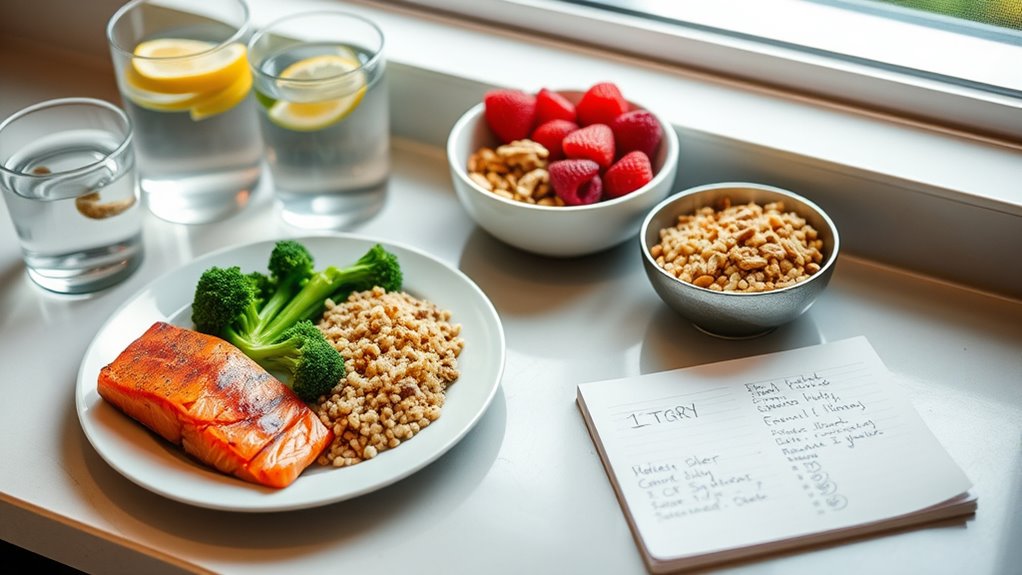
Adjusting your portion sizes and snacking habits can boost your energy levels throughout the day and support your overall health. Practicing portion control helps prevent overeating and maintains stable blood sugar levels. Incorporate healthy snacking to keep hunger at bay and avoid energy dips. Focus on nutrient-dense foods like nuts, fruit, or yogurt to fuel your body effectively. Be mindful of serving sizes, especially with high-calorie foods, and listen to your body’s hunger cues. Swap out processed snacks for whole foods to boost energy naturally. Keeping snacks balanced with carbs, protein, and healthy fats ensures sustained energy without crashes.
- Opt for small, frequent meals to stabilize energy
- Choose nutrient-rich snacks over sugary treats
- Use portion control tools like measuring cups for accuracy
Frequently Asked Questions
How Can I Adapt Meal Plans for Specific Health Conditions?
When adapting meal plans for specific health conditions, you should consider your dietary restrictions and make necessary nutritional adjustments. Focus on choosing foods that support your health needs, such as low-sodium options for hypertension or sugar-conscious choices for diabetes. Always read labels carefully and consult with a healthcare professional or dietitian. This way, you guarantee your meal plan promotes wellness while respecting your unique health concerns and preferences.
What Are Quick Meal Ideas for Busy Midlife Women?
When you’re busy, quick meal ideas are a lifesaver. You might try simple snack ideas like nuts, yogurt, or fruit to keep energy levels stable. Incorporate meal prep tips by preparing ingredients ahead of time—chopped veggies, cooked grains, or grilled proteins—so you can assemble meals fast. These strategies help you stay nourished without spending hours in the kitchen, making your busy days more manageable.
How Do I Manage Cravings While Maintaining a Balanced Diet?
Managing cravings while staying balanced starts with healthy snacking and mindful eating. When cravings hit, choose nutrient-dense snacks like nuts, fruits, or yogurt to satisfy hunger without overindulging. Pay attention to your body’s signals and eat slowly to enjoy each bite. This approach helps you resist impulsive treats, keeps your energy steady, and supports a balanced diet overall. Stay mindful and make intentional choices to manage cravings effectively.
Are There Vegetarian or Vegan Options Suitable for Midlife Women?
You can find plenty of plant-based options suited for midlife women, focusing on diverse protein sources like beans, lentils, tofu, and quinoa. These options provide essential nutrients and support overall health. Incorporate a variety of vegetables, nuts, and seeds to enhance your diet. By exploring different recipes, you’ll enjoy satisfying, nutritious meals that meet your dietary needs while embracing vegetarian or vegan lifestyles.
How Can I Involve Family in Healthy Meal Planning?
To involve your family in healthy meal planning, start by including them in meal prep strategies, like choosing recipes or shopping together. Encourage open discussions about everyone’s preferences and dietary needs. Assign simple tasks to kids or partners to foster teamwork. This approach makes meal prep more enjoyable, helps teach kids about nutrition, and guarantees everyone feels invested in the process, ultimately promoting healthier eating habits for your family.
Conclusion
By applying these meal planning tips, you’ll navigate midlife like a seasoned sailor steering through calm seas. Prioritize your needs, choose nourishing foods, and simplify your routine—making healthy eating feel effortless. Remember, it’s about progress, not perfection, and each small step adds up. With your efforts, you’ll feel energized and balanced, like a well-tuned instrument ready to play your best tune every day. Embrace the journey—you’re worth it.
